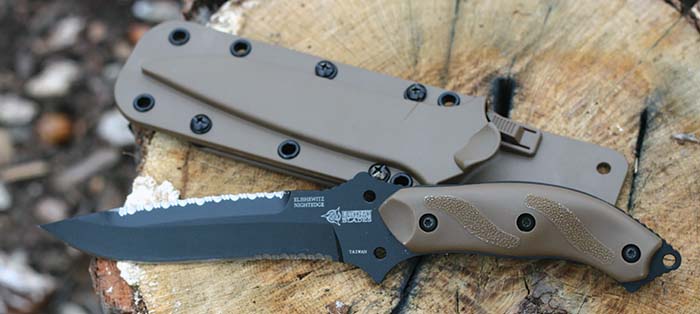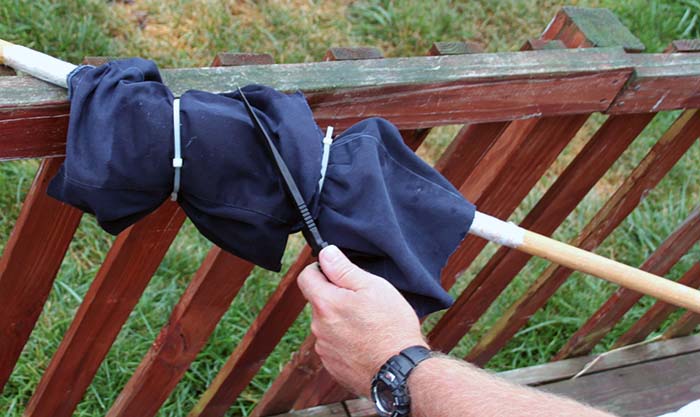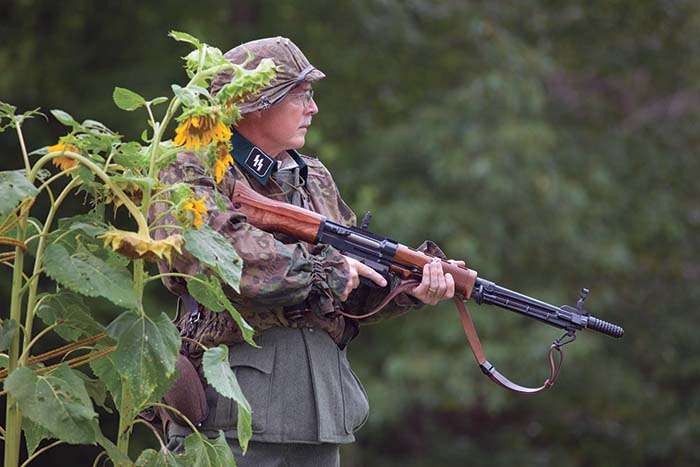The NightEdge was designed by Allan Elishewitz. The double serrated edges make the NightEdge a prime candidate to serve as a multipurpose knife.
By Todd Burgreen
There is a primitive appeal to an edged weapon that is hard to deny. In many ways proficiency with a knife in your hands can be considered more viable versus solely relying on firearms. Knives can be specialty models tailored made for CQB hand to hand applications to more utilitarian versions that can handle a variety of roles including survival situations. Someone proficient in terms of knife survival skills can vary responses to different situations and does not have to resort to a carried firearm for all situations; which frankly offers limited value in terms of shelter, food preparation, and other necessities. Not every survival situation warrants a firearm; more importantly a firearm may not be readily available either due to logistical or situational constraints you may find yourself in.
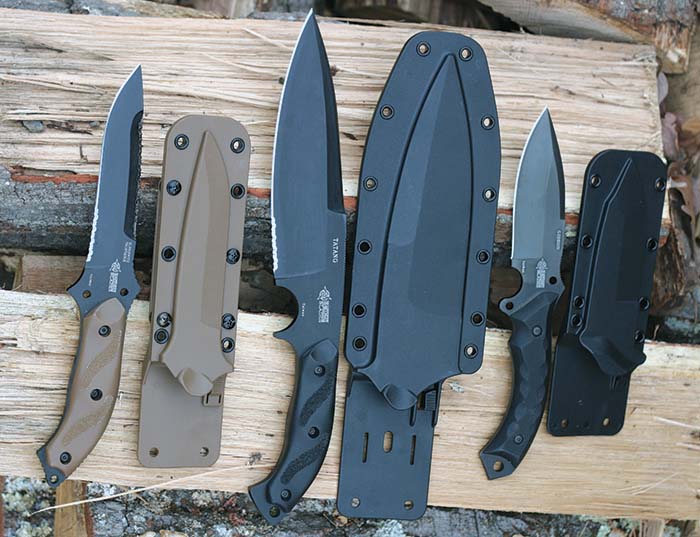
BLACKHAWK! (BH!) thought process for creating ancillary gear is wide ranging and evident in their holsters, breaching tools, boots, web gear, knives, etc. BLACKHAWK!’s knife product line is multi-faceted using ideas/concepts from leading designers in producing various models. One noteworthy aspect of BH! knives are their relative value compared to full blown custom knives on the market. This is achieved by producing knives outside the U.S. without sacrificing steel quality. Three BH! knives will be featured in an effort to cover the most ground in terms of what is offered: Tatang, NightEdge, and Gideon.
The BH! Tatang is based on the Filipino Barong. The Tatang was designed by Michael Janich while he was working at BLACKHAWK!. Janich has been studying and teaching self-defense and the martial arts for more than 30 years and has earned instructor’s credentials in American Self-Protection (ASP – an eclectic art that includes elements of judo, aikido, boxing, fencing and French Savate), the Filipino art of Serrada Eskrima, and Joseph Simonet’s Silat Concepts and is a member of the elite International Close-Combat Instructors’ Association. He has also trained extensively in wing chun gung fu, tae kwon do, wu ying tao, Thai boxing, arnis de mano and military combatives. Mike’s own Martial Blade Concepts (MBC) program, which the author has attended, is edged-weapon training specifically designed to meet the needs of today’s concerned citizen and armed professional. MBC is based on extensive analysis of the Filipino martial arts and many other systems and emphasizes the development of “all-purpose” defensive skills.
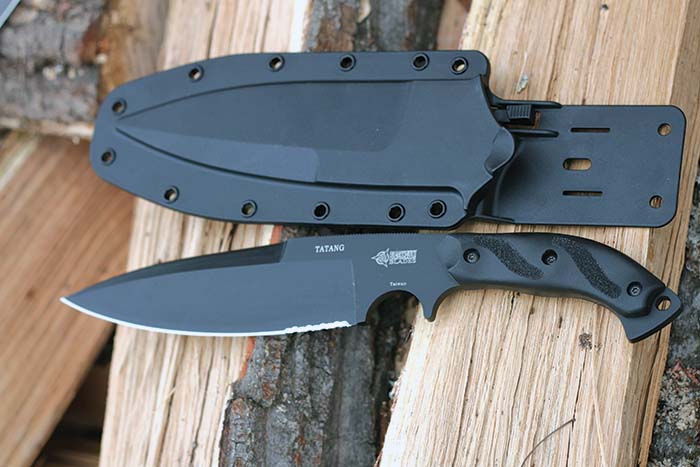
The Moro Tribes were some of the first to use the Barong and the design was said to have been based on the shape of a leaf from that region of the world. Traditional Barongs have blades ranging anywhere from 8-22 inches in length and weigh a pound or more creating a formidable fighting knife. The BH! Tatang is a modern version of the ancient Moro Barong knife, with a number of Janich tweaks incorporated by BH!. The first is the finger notch in the blade’s choil area (an unsharpened section of a knife blade) that allows you to place your index finger there for greater control. This is further assisted by the knife being balanced in this area as well. A rough textured area on the back of the Tatang blade in front of the grip is for thumb placement for more control if desired in the large blade. Gripping the rear of the rubber textured handle grants greater leverage for devastating thrusting or slicing cuts. The back edge of the Tatang is sharpened as well for back cuts. The large sharpened section of the back edge lends a dagger like aspect to the Tatang enhancing its penetration prowess when used as a dagger. The blade thickens up behind the back edge on the way back to the handle. The Tatang’s blade length is 8.6 inches with an overall length of 13.5 inches. 1085C high-carbon tool steel is used from tip to tang with the Tatang. The Tatang weighs just over 15 ounces. The Tatang’s dual edges are extremely sharp out of the box. The concept behind the Tatang can be grasped as a user wanting a heavy bladed “short sword.” The heavy Tatang blade has enough weight to give sufficient force in a slashing attack, while permitting the use of cut-and-thrust fighting tactics. This is the main reason for the Barong/Tatang’s popularity as a fighting knife – it can slash as well as thrust with equal efficiency. One often hears that skill will trump blade size. There is a certain amount of truth to this and there is no substitute for size when it comes to a fighting knife. The Tatang definitely recognizes this aspect of the effectiveness equation for a knife. There is purity in Tatang’s simplicity and was designed for proactive/aggressive knife fighting and is the quintessential combat knife.
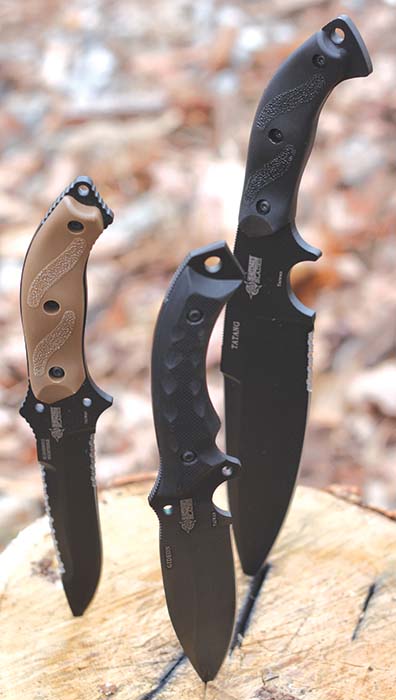
BLACKHAWK!’s knife product line is multi-faceted using ideas/concepts from leading designers in producing various models.
The second BH! knife examined is the NightEdge. The NightEdge can be considered a multipurpose blade able to serve equally as well as a fighting knife or a general field knife in a survival situation. The double serrated NightEdge was designed by Allen Elishewitz. Serrated edges are present along the back of the knife for heavy draw cuts as well as a short section of the blade edge near the hilt. The NightEdge’s serrated back edge makes short work in terms of cutting any rope or sawing thru wood with efficiency. There is a built in guard on the blade in front of the grip to help protect your hand from sliding onto the blade. The top guard has friction grooves for your thumb when using a fencing type grip. The NightEdge features a 5.9 inch 1085C high carbon steel blade that is covered with a black epoxy finish. Overall length of the NightEdge is 10.9 inches. The handle is rubber with textured panels for a sure grip. The BH! NightEdge is not meant for fencing or parrying; it is meant for stabbing and ripping. There is no doubt that the NightEdge would be at home on web gear, belt or chest rig of any soldier, law enforcement, or security conscience civilian with a chance of coming into direct action contact with a foe or possibly requiring its assistance in more mundane survival type chores.
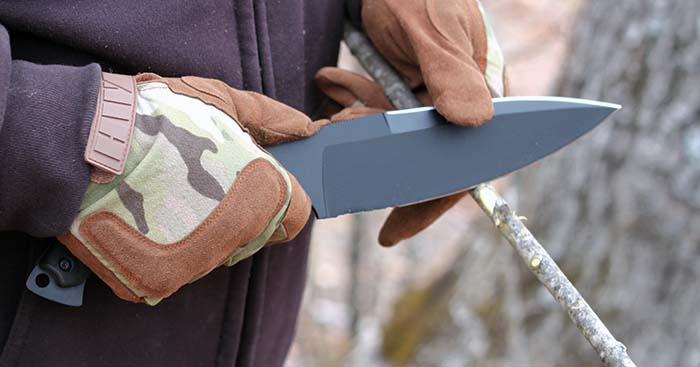
The serrated edges on the NightEdge will lead many to assume it as being more of field implement than a pure fighting knife. This is not the case. Elishewitz specified the NightEdge with a single grind edge grind; this produces a reinforced point for extreme tip strength and penetration that is important for field use. Also, testing has shown that the force required to penetrate tissue is directly related to the sharpness/fineness of the tip. The sharp tip combined with the extreme ramp-like shoulder results in the NightEdge penetrating deeply very quickly. By allowing the NightEdge to maintain a thicker point by not grinding down the blade on both sides all the way to the end, it allows the blade to retain its rigidity and strength all the way from the handle to the tip.
A field knife should be thought of as a utilitarian tool. A field knife serves a myriad of functions such as cutting, digging, splitting wood, food prep, first aid, shelter building, fire making, hunting, prying, signaling, hammering, and lastly self-defense. Two holes at the base of the blade as well as near the pommel are for tethering the blade to a pole for use as a weapon or spearing fish for example. Not wanting to cause a stir, but any knife can be deployed for combat while the reverse cannot be said for a knife being able to perform as a utility/survival knife. Many fighting knives are not up to the task of chopping or heavy work; think about likelihood of a dagger or stiletto suffering structural failure while attempting to procure fire wood.

The last knife from BLACKHAWK! is the Gideon. The Gideon features G 10 handles and constructed from stainless AUS8A steel. This grip design will not only provide secure purchase no matter conditions, but it is easily disassembled and cleaned of any blood borne pathogens in the field. (All of the BH! knives featured in this article feature this capability as well as full tang design.) This stainless steel is one of the easiest to sharpen while still holding an edge even after serious use while offering superior corrosion resistance especially when compared to carbon steel blades. The 5 inch blade is coated with black Ti-Nitride further supporting resistance to rust. The Gideon has great aesthetics from blade tip to skull crushing pommel. The Gideon is a more traditional drop point blade design. A drop point is one of the most popular blade shapes in use today. The back edge of the knife, which is unsharpened, runs straight from the handle to the tip of the knife in a slow curved manner creating a lowered point – thus the drop point nomenclature. Thanks to its design, the drop point features a strengthened tip compared to other blade configurations; thus drop points such as the BH! Gideon are popular tactical and survival knives. The Gideon adds a finger groove in front of the quillion (cross guard) for increased control and dexterity during skinning or other more delicate chores.
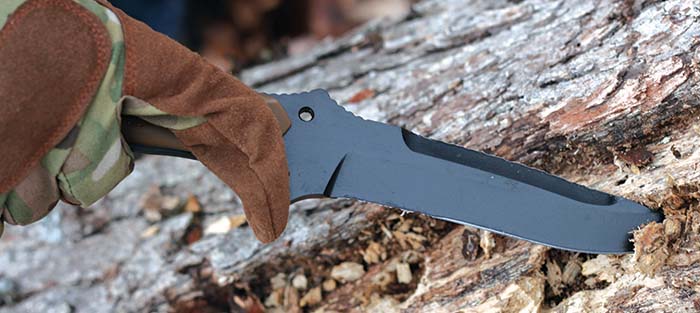
The initial impression of holding the BH! Gideon was how balanced it was, especially considering its blade length. You want a balanced knife, especially one the size of the Gideon, to enable the user to employ it in a fashion that best suits individual skill. The user wants something light enough to carry but still heavy enough to slash efficiently if needed, while maintaining size for fight stopping thrusting ability. The Gideon’s blade profile enhances penetration of the blade when stabbing. As the Gideon blade enters its creates a “wedge” forcing the cutting edge down as it moves forward, shearing along its length and penetrating extremely well. For personal defense, this allows the knife to penetrate very effectively, even through heavy clothing. It’s kind of like being a “large caliber” knife – a bigger cut means a more significant wound channel. The large “back” or “wedge” also allows better placement of the thumb, which enhances one’s ability to apply downward pressure. It also allows the knife to be removed easily instead of binding-up in the target thus facilitating rapid multiple strikes.
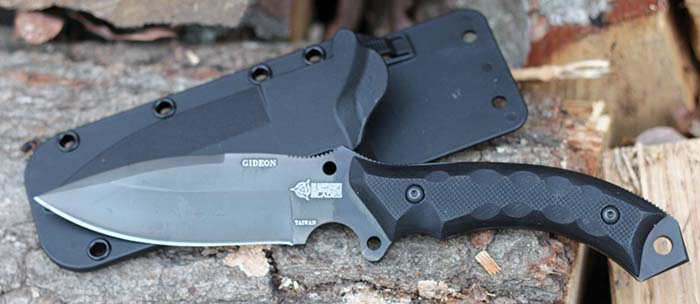
It would be problematic to represent that any of the BLACKHAWK! blades – Tatang, NightEdge, Gideon – as being a type of blade convenient for daily carry in a civilian personal defense role. The non-descript folder is hard to beat for this. The BH! blades are fighting/survival knives meant for attachment either to existing tactical gear set up or belt where open field carry suitable. BLACKHAWK! provides injection molded nylon sheaths with all three blades with mounting plates for PALS/MOLLE or drop-leg platform attachment. The sheath will accept any of the various BLACKHAWK! attaching mechanisms allowing for flexible mounting to gear. BLACKHAWK! Mod-U Lok belt attachments are available as well for even more options along with BLACKHAWK! belt and paddle attachments that serve with the handgun holsters. The numerous reinforced eyelets around the sheath body are another means of rigging the BH! knives to gear. One aspect that was scrutinized with the BH! sheaths was the finger tab release mechanisms that serve as retention devices. This was found on all the knife sheaths. The finger tab was problematic to reach with the off hand. It was discovered that the sheath could be pushed away enough with your fingers to facilitate extracting the blade from the sheath by-passing the finger tab release. This could not be verified if by design or not.
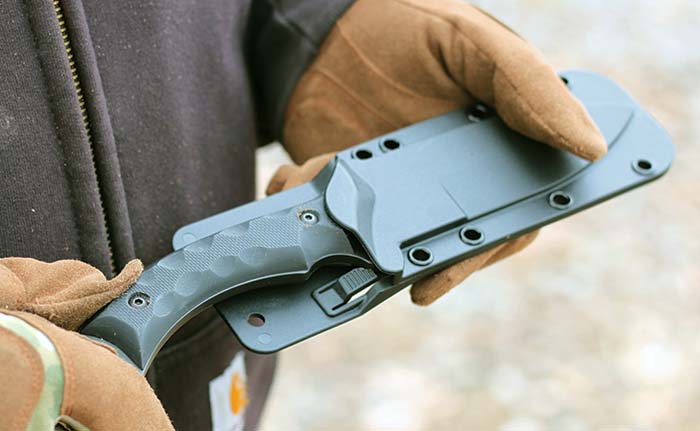
A standard knife evaluation involves a “porkman” used to evaluate both slashing and thrusting effectiveness. This was discovered during a Mike Janich course attended years ago. During the course, Mike did a demonstration involving a bone-in pork roast butterflied around a broom handle, wrapped in plastic, and covered in multiple layers of clothing. With minimal effort Mike proceeded to slice and dice the pork roast showing how effective even a small folding knife can be. The “porkman” test offers an evaluator a means to test a blade’s effectiveness in a medium simulating an adversary’s clothed limb. After starting out slowly to get a feel for manipulating the different BLACKHAWK! blades, the knives slashed through the wrapped “porkman” with no hesitation down to the broom handle simulating bone. The “backcut” technique utilizing the sharpened back edge on the Tatang had no problem slashing through the denim/plastic covered “porkman” making a severe gash. The flick of the wrist with the Tatang produced what would be labeled a serious wound. The BH! knives had no issue thrusting to their hilts into the test medium. No real resistance was encountered penetrating the “porkman” layers of denim/plastic or meat.
All of the BLACKHAWK! blades excel at thrusting while maintaining ability to slash/cut as well. This is a derivative of Western culture preferences when it comes to knives. Even though the Tatang is based on the Filipino Barong knife, Janich’s tweaks make it more proficient in thrusting applications compared to the Barong. Something that has always resonated with the author is reading blade guru James Keating expressing how East and West could be defined by knife method; East with the edge/slash and West with the point/thrust. The point/thrust as perfected by Western culture traces its roots to Greek/Roman traditions. These early cultures realized that the most expedient means to stop someone who is trying to kill you is to access one or two vital organs and damage them. Trying to stop someone bent on causing bodily harm by slashing will not produce a stop in a timely manner.
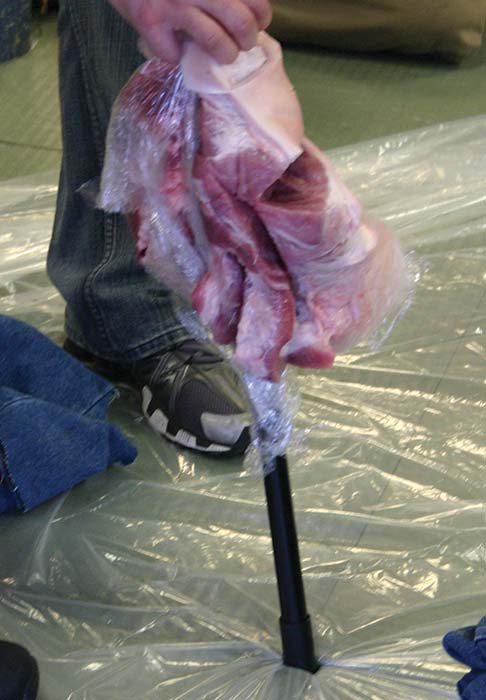
A basic knowledge of anatomy is useful for knowing how best to employ a knife effectively. The BLACKHAWK! Tatang, NightEdge and Gideon knives’ design and size allows for direct use on limbs, head or spinal column. One’s imagination and common sense will suffice as to the lethality of a BH! knife by a man full of adrenaline in a “me or him” situation. Hand to hand combat is an obvious close range affair with an enemy often appearing suddenly. The balance, power and reach of the BLACKHAWK! blades evaluated herein is invaluable. It is consoling and a real morale booster to know that your blade of choice outclasses any opponents’ knife in terms of utility, durability, power, reach, and lethality.
Sites of interest
www.BLACKHAWK.com
| This article first appeared in Small Arms Review V19N5 (June 2015) |



